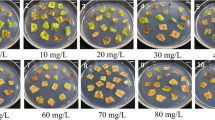Abstract
To overcome the difficulty in obtaining mutants of the citrus strains of Xylella fastidiosa, we evaluated mutagenesis using the transposome system as a tool for the isolation of a large number of mutants. Electroporation of a commercial transposome system in X. fastidiosa CVC (Citrus Variegated Chlorosis) strain J1a12 yielded an efficiency of 1.2 × 103 kanamycin (Km)-resistant clones per μg of DNA. Southern blot analysis demonstrated that the transposon was randomly inserted, and nucleotide sequence analysis indicated the presence of 9 bp direct repeats flanking the transposon insertion site. Analysis by PCR of one of the insertion mutants (clone J15) showed that the transposon was stable after eight passages in solid media. These results show that the transposome system can be used to generate a random mutant library of Xylella fastidiosa CVC strain.
Similar content being viewed by others
Author information
Authors and Affiliations
Rights and permissions
About this article
Cite this article
Koide, ., Neto, ., Gomes, . et al. Insertional Transposon Mutagenesis in the Xylella fastidiosa Citrus Variegated Chlorosis Strain with Transposome. Curr Microbiol 48, 247–250 (2004). https://doi.org/10.1007/s00284-003-4189-z
Issue Date:
DOI: https://doi.org/10.1007/s00284-003-4189-z




